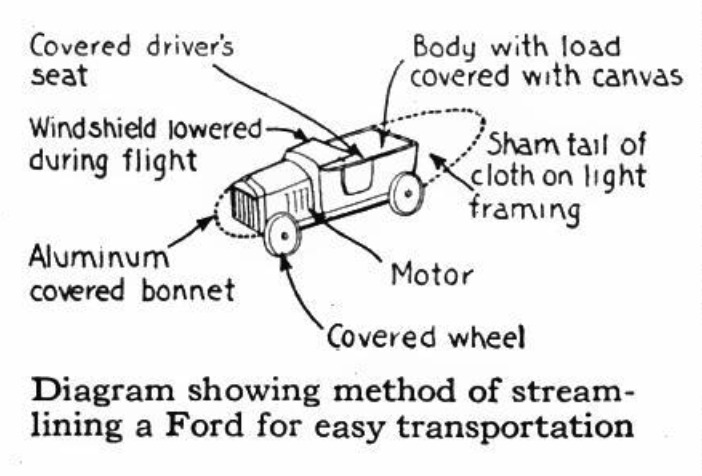-
Title (Dublin Core)
-
Using a Ford as an Airplane-Tender
-
Article Title and/or Image Caption (Dublin Core)
-
Using a Ford as an Airplane-Tender. It could be done if the tender were designed to offer the least possible resistance to the air
-
extracted text (Extract Text)
-
FROM afar comes the rolling thunder
of the field guns, heavy blasts mark-
ing the rhythm of the heavy artil-
lery. The sharp staccato of the machine
guns and the spiteful cracking of the rifles
cannot be heard so far behind the battle
line. Undisturbed by the distant din
and turmoil the birds are singing, feed-
ing and making love as if there were
no such things as bloody war and de-
struction.
Suddeniy their singing, twittering and
chirping cease. Their sharp ear has
heard a strange sound to which it has not
yet become accustomed as it has to the
distant din of battle. It is a whirring
sound, at first faint, yet sharp and per-
sistent. As it approaches it becomes
louder and more terrifying. The birds
flutter around and seek shelter.
A few moments later an airplane of a
strange type appears above the treetops,
makes a sharp curve and, with a graceful
glide, comes to rest upon the clearing
which crowns the top of the hill. It is a
huge monster. Wings
of great expanse and
a tail in proportion
rest upon a strange big
body, streamlined and
provided with wheels.
The pilot and his ma-
chinist descend and
from somewhere four
other men, wearing sol-
diers’ uniforms swarm
out of the body of the big
monster. There is some hurried activity
and after a few minutes the big body is de-
tached from the airplane, which then,
greatly lightened, is ready for its return
journey. The pilot and the machinist
clamber to their respective places, a
hearty “Good luck!” a wave of the hand,
and, with a short run the machine rises
from the ground and quickly ‘disappears
behind the treetops flying in the direction
from which it had come a short time
before. :
The body of the monster, relieved by
the busy hands of the soldiers of its
streamlining shell of canvas and alu-
minum, proves to be a Ford, carrying
two machine guns and a load of ammuni-
tion and provisions, in addition to the
gasoline required for a long trip. The
shell is folded up and loaded on the car
by three of the men, while the fourth is
busy around the engine, putting it in
shape for an immediate start. Five
minutes later the Ford is mounted by the
four soldiers and chug-chugs away in the
direction of the battlefront.
The scene pictured in the preceding
lines is merely imag-
inary, but it may
become actual, if the
suggestion of L. R.
Carroll, of Roundup,
Montana, is adopted
and carried through by |
the government. |
The giant flyers of to-
day have ample lifting |
power to carry a Ford |
together with its cargo. |
Aerial transportation does not balk at the
weight tobecarried, but at theindifferently
shaped bulk of the load. A narrow motor-
cycle may be lashed to an airplane, as it
is, but any ordinary automobile would
kill the plane’s supporting power by the in-
ordinate head-resistance it offers to the air.
Racing automobiles have recently been
designed with great care, so as to reduce
the resistance they offer to the air, a
policy which, in racing, is as vital as in
flying. A racing car may be lashed to
an airplane as readily as a motorcycle.
But a Ford car is not built on racer
lines. The Ford would first have to be
thoroughly streamlined and its wheels
would have to be changed to disks by
spoke-coverings. The problem still re-
mains of providing an extra set of wheels
for the airplane on which to restart and
to reland after it has dropped its load.
But that does not seem impossible of solu-
tion, judging from the example of the large
German seaplanes, which are transform-
able into land-planes. These carry a set
of wheels that may be lowered at will.
The plan may be carried out with a
Ford even more easily than with the sea-
plane, because the twin-engined planes
have their landing wheels under each
motor, and the Ford could be suspended
between them. The wheels of the Ford
could form a landing gear of its
own, taking its weight in landing and
starting off the structure of the plane.
The Ford would require no redesigning. |
Light framings with canvas or aluminum
covering could transform its outline into a
perfect streamline, which would be ma-
terially aided by a long empty tail.
-
Contributor (Dublin Core)
-
Carl Dientsbach (writer)
-
Language (Dublin Core)
-
eng
-
Date Issued (Dublin Core)
-
1918-05
-
pages (Bibliographic Ontology)
-
643-644
-
Rights (Dublin Core)
-
Public Domain (Google digitized)
-
Archived by (Dublin Core)
-
Filippo Valle
-
Alberto Bordignon (Supervisor)
 Popular Science Monthly, v. 92, n. 5, 1918
Popular Science Monthly, v. 92, n. 5, 1918



